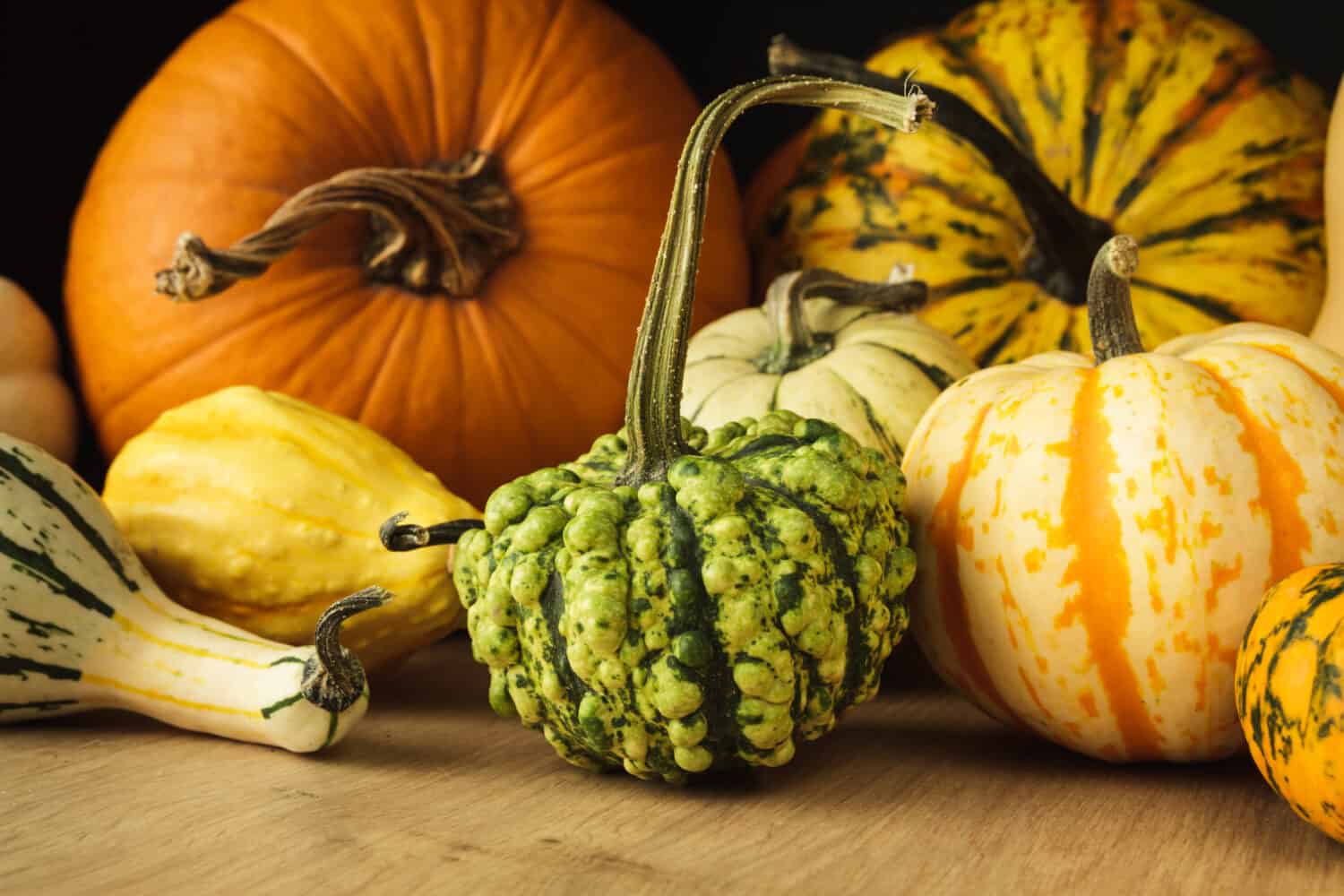The many types of squash are some of the most nutritious vegetables on the planet. There are many squash types, and each one brings its unique taste and texture to the table, making them versatile ingredients in a wide range of culinary delights. Whether you enjoy them in savory dishes, soups, salads, or even as a low-carb pasta substitute, the squash varieties will surely add color, flavor, and nutritional value to your meals.
You may have heard of the terms summer squash and winter squash. While they are both squashes, they differ in growing times, texture, and maturity. Summer squash is soft and tender and has a short shelf life, while winter squash has hard and thick skin with a long shelf life.
The number of recipes that utilize squash is huge! You will never be short of flavor or meal options to delight family and friends. So, next time you’re looking for texture, flavor, or nutrition, remember there will always be the right squash for the occasion.
Let’s explore 14 different types of squash, their taste profiles, and their best uses!

1. Zucchini Squash
Zucchini (Cucurbita pepo) was brought to the U.S. from Italy and was originally called zucchino. This delicious green summer squash resembles a cucumber but has a woody stem, often a flower, on one end. Zucchini is a firm, dark green, summery vegetable with a pale yellow center that you can roast or sauté them.
Zucchini is a type of squash with a mild, slightly sweet flavor, making it the ideal vegetable for sweet and savory dishes. When cooked, they become tender. Some of the best ways to cook zucchini are to saute them in a stir fry, add to a pasta dish, or roast them in the oven for a tasty treat.
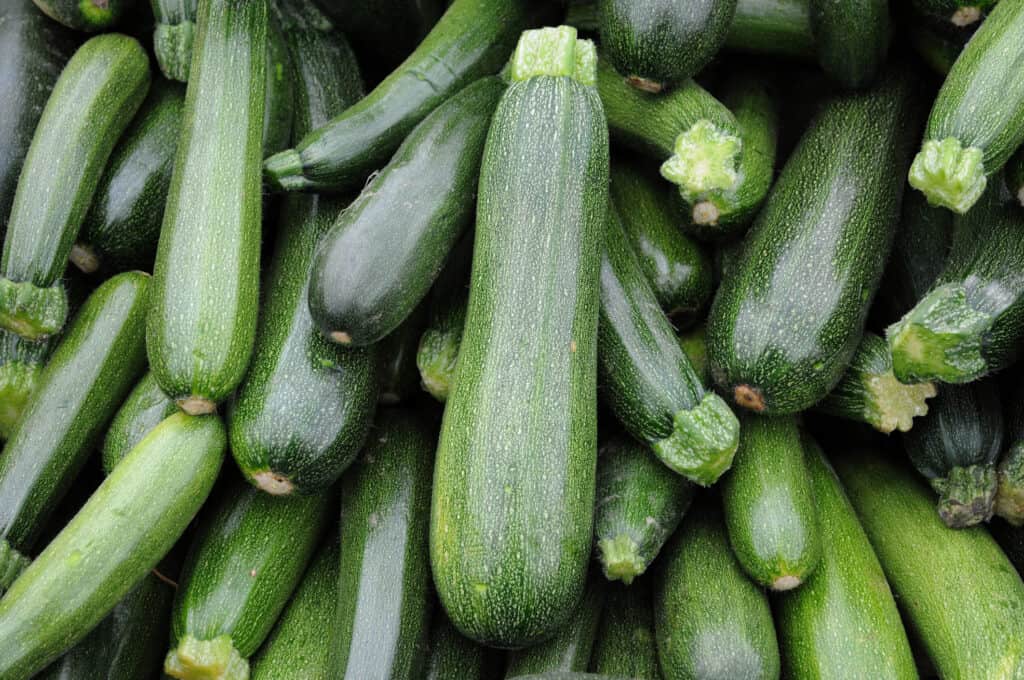
A cooking favorite, zucchini squash is a delicious vegetable that tastes great when roasted in the oven with seasoning and olive oil.
©iStock.com/Pack-Shot
2. Yellow Squash
You might have seen yellow squash and zucchini being sold as a package in the stores. Both summer squashes have similar nutritional content, texture, and cooking methods. Yellow squash has a yellow to gold, smooth skin and originates from Mexico and the Americas. In addition, it only takes 50-70 days to harvest from seedlings.
Yellow squash has a mild, sweet taste but won’t overpower a meal. So, eat it raw in a salad or grill it in a stir fry. You can’t go wrong with this delicious summer squash.
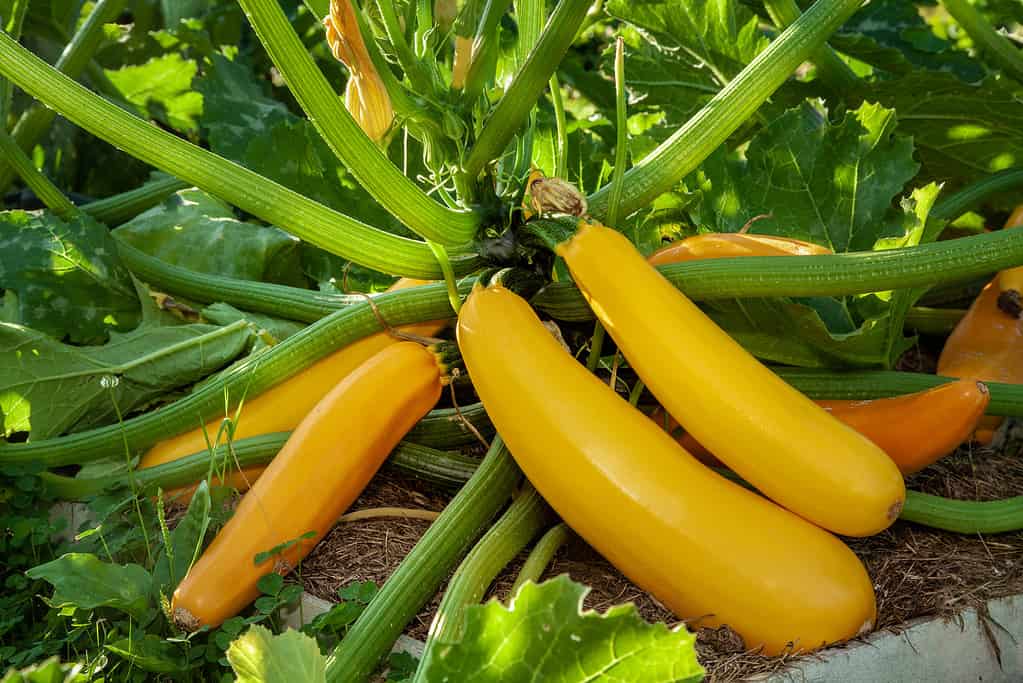
Yellow squash and zucchini squash have similar flavor profiles and use.
©Zhukovskaya Elena/Shutterstock.com
3. Butternut Squash
A winter squash favorite, butternut squash is loaded with nutrients, including beta-carotene and alpha-carotene, to support your immune system. This versatile vegetable is a bulb shape with a thick neck — almost pear-shaped. They have smooth orange skin and edible seeds in the center of the bulbous end.
Make a sweet dish by caramelizing butternut squash with brown sugar, bake butternut as a side dish to ham or turkey, or roast them in the oven as a savory dish; your options are endless. But don’t let those seeds go to waste. Roast butternut seeds for a healthy snack! Butternut squash has a mild, nutty, sweet flavor all will enjoy.
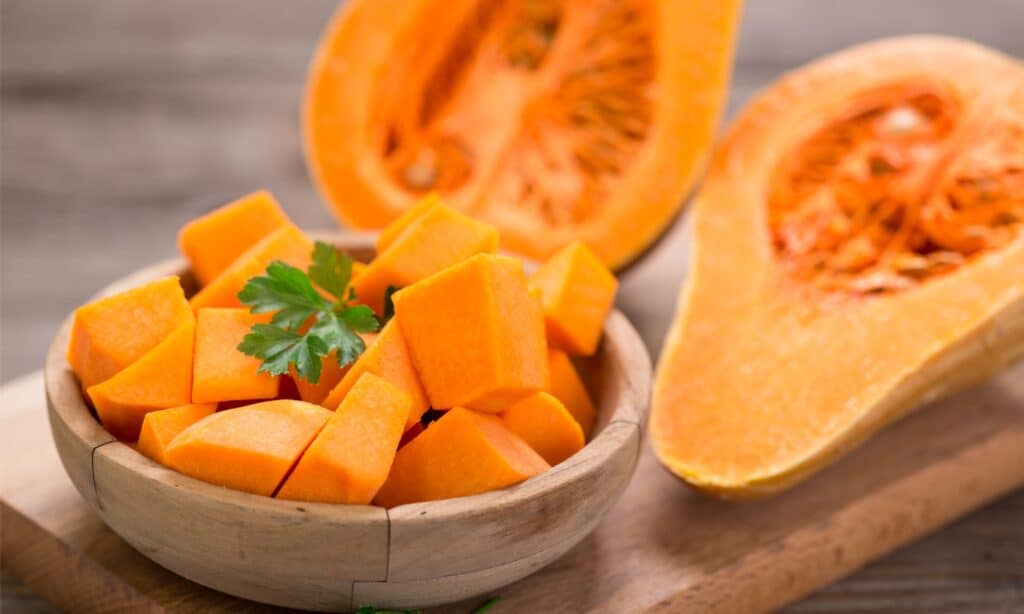
Butternut squash is a popular, nutritious squash type that’s commonly eaten throughout the fall and winter worldwide.
©iStock.com/pilipphoto
4. Pattypan Squash
Another summer squash for the win! While known for its round saucer-like shape, pattypan squash is a summer squash with creamy white, tender flesh. They are a great source of niacin, magnesium, and vitamins C and A.
You can grill, oven roast, sauté, or air-fry patty pans. If you’re feeling adventurous, make pattypan pancakes! Pattypan squash tastes similar to zucchini, just with a more bitter flavor. Since it has a mild flavor, pattypan will taste like the seasoning you pair it with. It’s one of those types of squash that can taste like anything!

Pattypan squash has an interesting, saucer-like shape and a somewhat bitter flavor.
©Irina Zharkova31/Shutterstock.com
5. Delicata Squash
Although they have a short shelf life, delicata squash is a colorful and flavorful winter squash. They have an oblong shape and are around three to six inches with orange and green stripes. Also known as peanut squash, delicata squash has a sweet, nutty, buttery flavor that will elevate your dish.
Delicata squash has thin skin and tender flesh, making preparation and cooking time much shorter than other squash varieties. Since it is so flavorful, you can slice a delicata squash, add some olive oil, salt, and pepper, and slow roast it until tender or crispy, according to your preference.
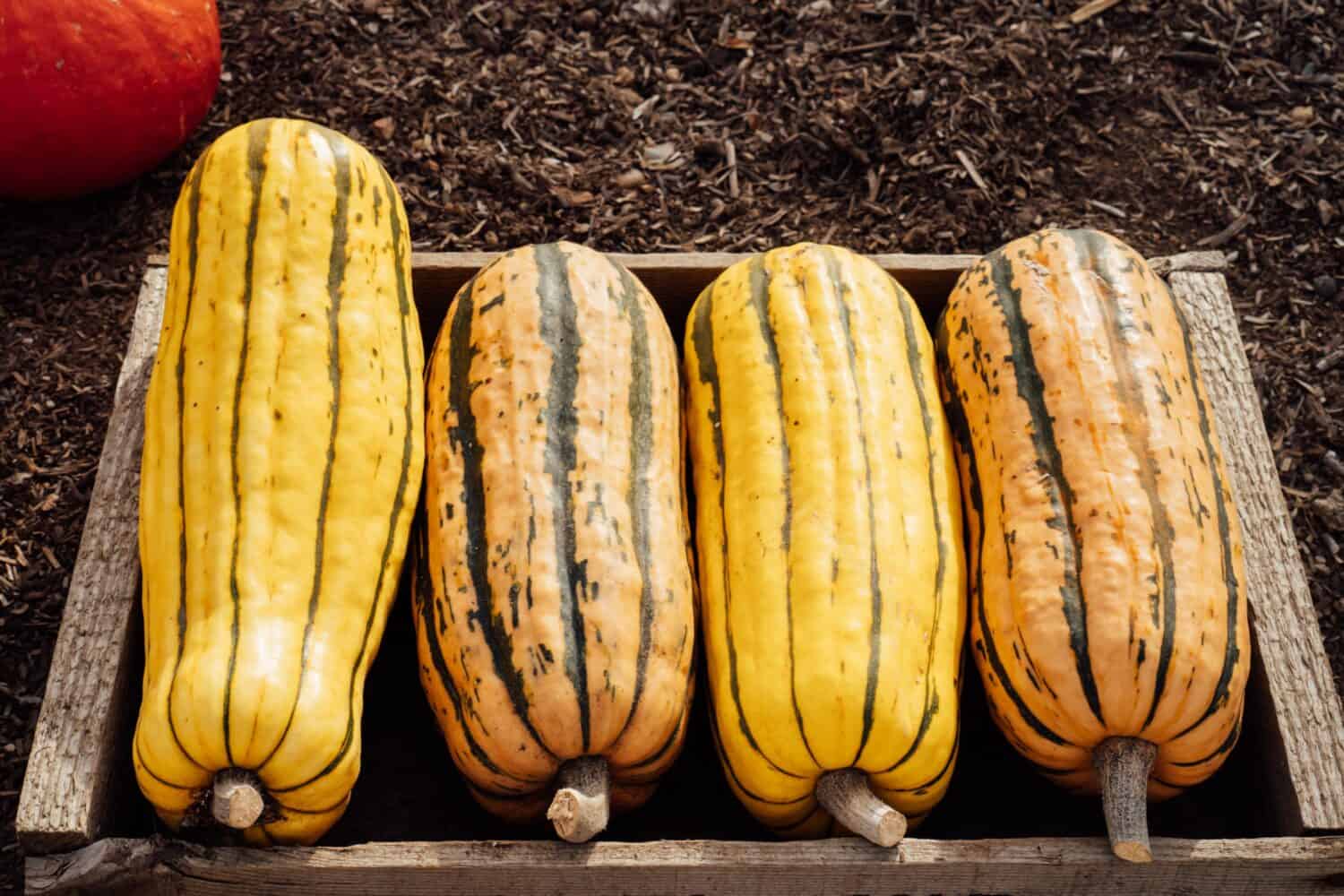
Delicata squash, also known as peanut squash, has a sweet, nutty flavor.
©Okrasiuk/Shutterstock.com
6. Acorn Squash
If you’re looking for a winter squash with a long shelf life, acorn squash can last three months when stored in a cool, dry place. They vary in color, from dark green to white, and have a unique acorn-like shape. What’s another thing to love about these types of squash? They are packed with nutrients, such as vitamins C and B, magnesium, and potassium.
Acorn squash has a fibrous texture with a mild buttery taste. The popular way to cook acorn squash is by baking them. Cut the squash in half and scoop out the seeds. Add half a teaspoon of butter and sprinkle brown sugar and maple syrup over the squash. Serve when the flesh is tender! Acorn squash is a versatile vegetable and makes a great acorn squash soup or roasting in the oven for a delicious side dish.

Acorn squash is a type of squash with a mild buttery taste and is loaded with essential nutrients.
©iStock.com/MSPhotographic
7. Gold Rush Squash
A zucchini hybrid, gold rush squash has a waxy texture and beautiful gold-yellow color. Gold rush squash has a similar taste and shape as a zucchini, including the woody stem on one end of the vegetable. This delicious squash is flavorful and easy to grow and an AAS winner! Gold rush squash has a mild sweetness and nutty flavor you have to try.
The flesh is tender when cooked, but you can also eat it raw by slicing it into salads or eating it with dip. Along with eating gold rush squash raw, you can roast them on a grill, steam them, or add them to a tasty stir-fry.
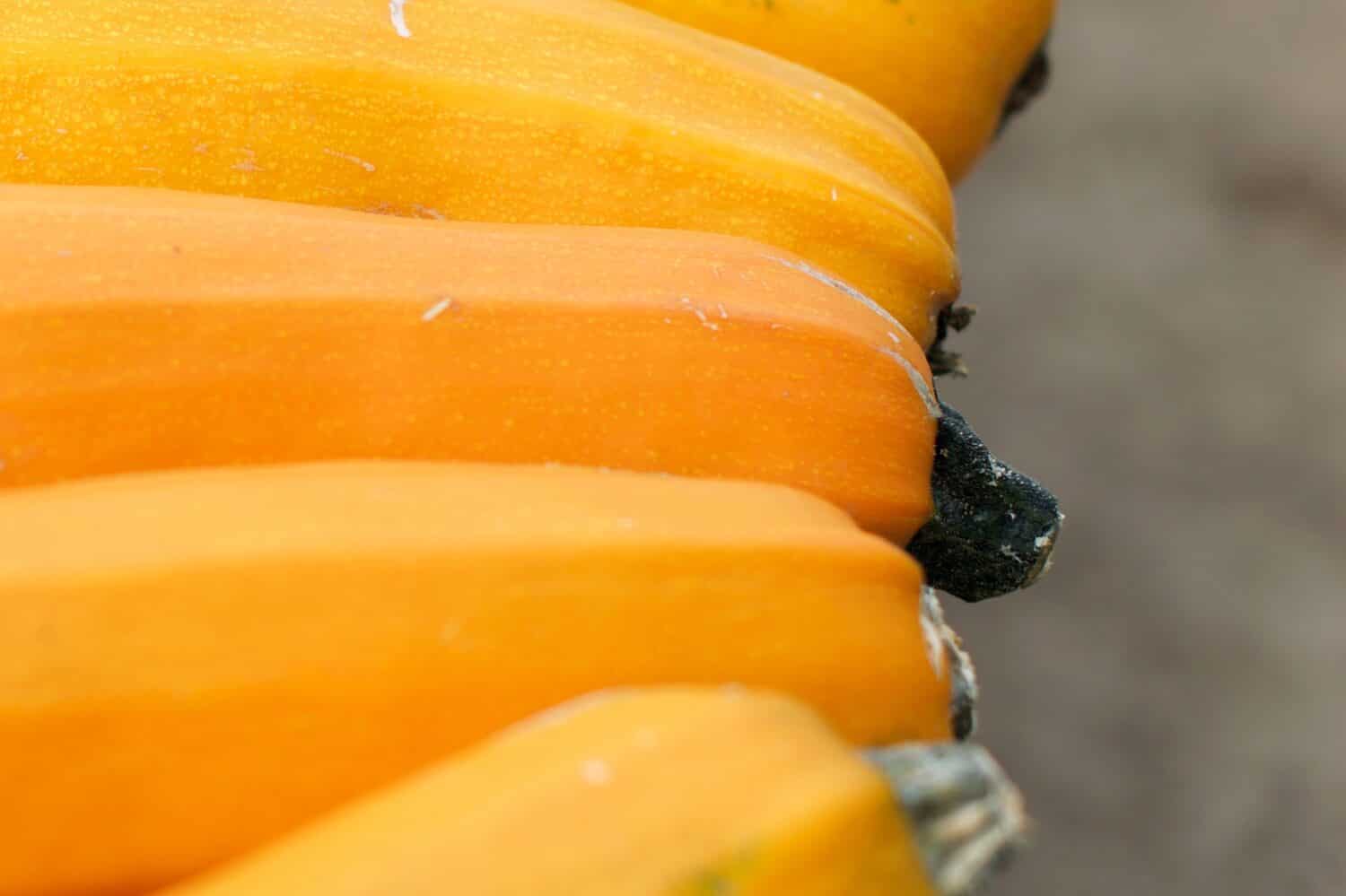
Gold rush squash has a mild, nutty flavor and can be eaten raw or cooked!
©Anicka S/Shutterstock.com
8. Chayote Squash
Chayote squash is a summer squash often used in Latin cuisine. Also known as mirliton and choko, chayote squash is high in vitamins and antioxidants, making it great for your body and mind. Be sure to consume the skin, as most nutrients are there!
Chayote squash has a subtly sweet and refreshing flavor. This healthy squash will pair well with lime juice in a salad, or you can pan-roast it with spices such as chipotle or curry. You can sauté chayote squash with garlic and onions for a simple yet flavorful side dish.
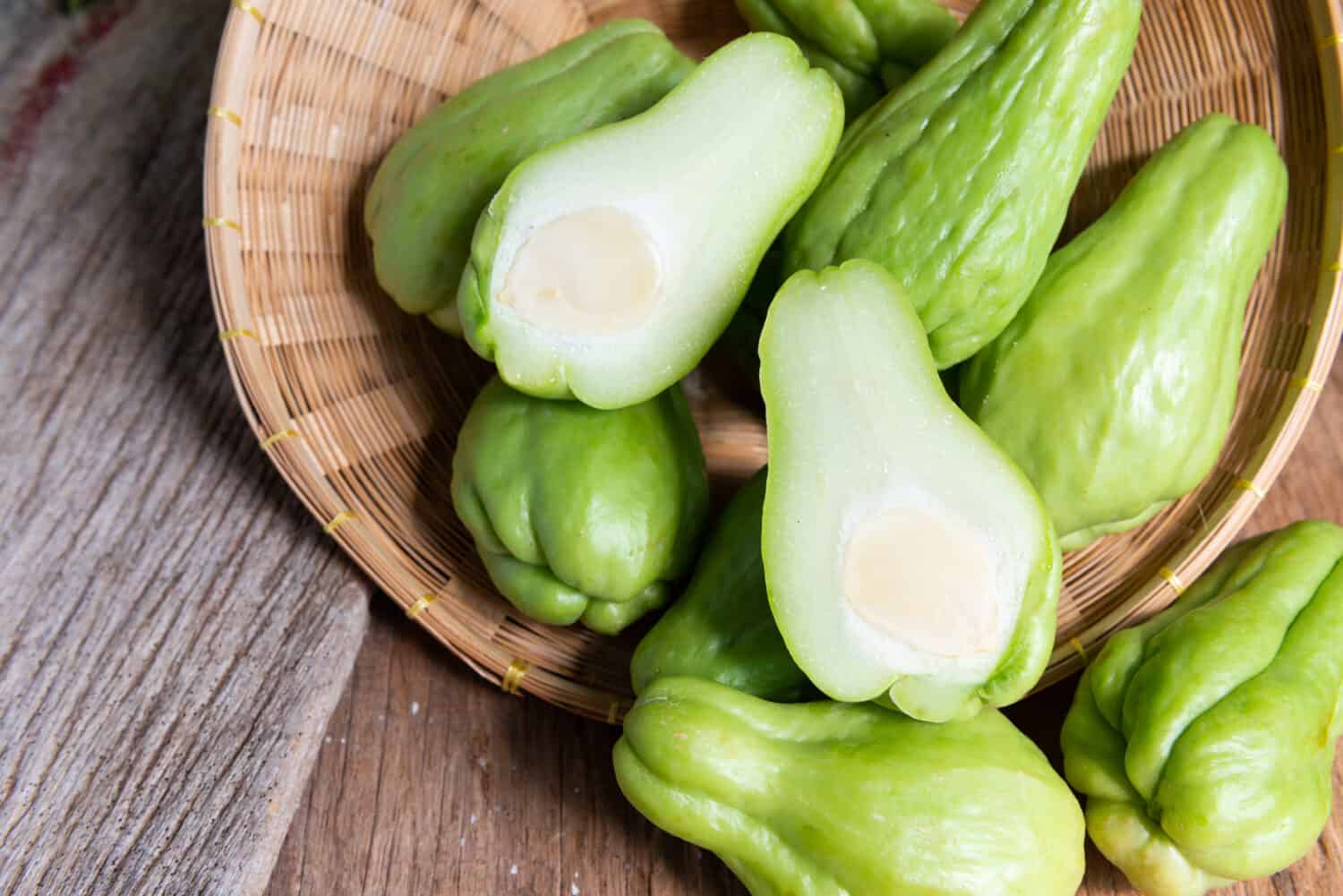
Also known as choko, chayote squash is a healthy squash with a sweet and refreshing flavor.
©Regreto/Shutterstock.com
9. Bonbon Squash
Bonbon squash is a versatile hybrid winter squash developed from the buttercup squash variety. The rind is dark green with silverish streaks, and beneath the hard skin, you will find a tender, bright orange flesh that is dense, fine-grained, and smooth. When cooked, it becomes creamy with a delicate sweet taste.
This versatile, delicious squash can be used in various dishes like roasting, baking, and soups. Because of the bonbon’s sweetness, many food connoisseurs have explored using it to make delectable, lip-smacking, tasty desserts. If you have an abundance of bonbon squash, you can cook and puree it to freeze for later use.
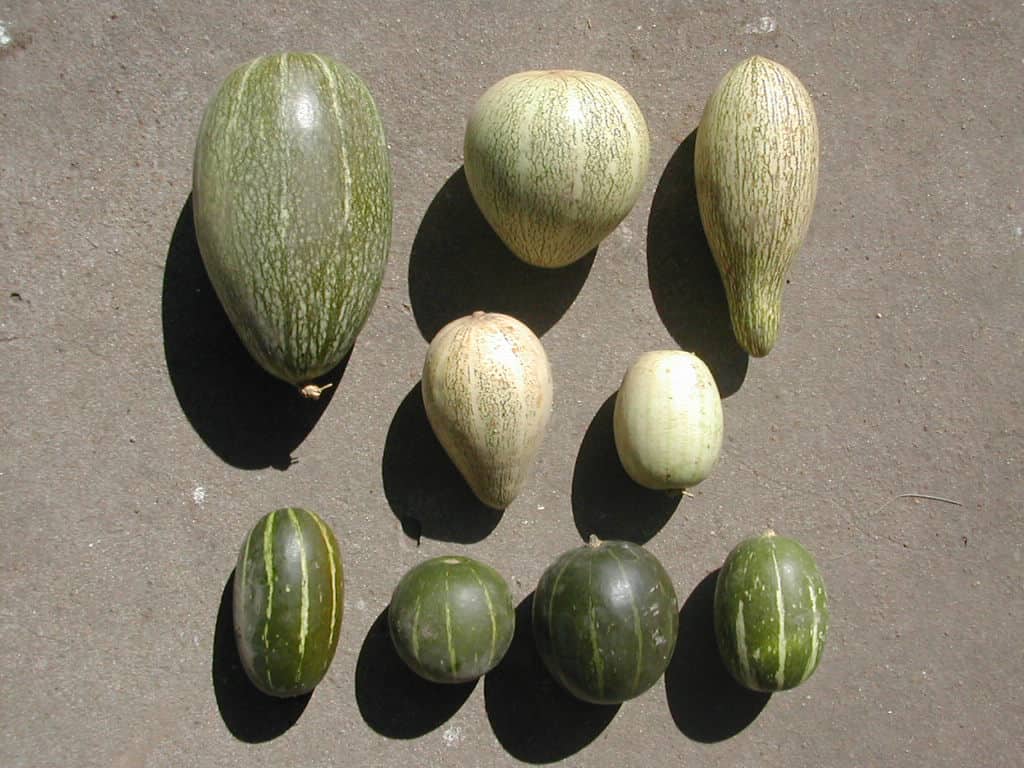
Bonbon squash is a varietal of
Cucurbita maximasquash, shown here, one of the most diverse domesticated species.
10. Buttercup Squash
Buttercup squash is typically smaller than other winter squashes and has a round to slightly turban-like shape with a flat bottom. This squash has a distinctive dark green color on the outside with lighter green stripes. The flesh of the buttercup squash is dense, smooth, and dry. Its slightly sweet and nutty flavor makes this squash a favorite for various culinary applications.
Nutritionally, buttercup squash offers several health benefits. It is a rich source of vitamins A and C, essential for a healthy immune system, vision, and skin. This versatile vegetable is great to be mashed, baked, or stuffed. But an all-time hearty option is roasting. Cut the squash into slices or cubes, season with olive oil, salt, and pepper, and roast until tender. Simply delicious!

Also a popular winter squash, buttercup squash is high in vitamins and can be cooked in a variety of ways.
©Brent Hofacker/Shutterstock.com
11. Honey Bear Squash
Honey bear squash is a smaller-sized acorn squash variety with a distinctive shape featuring deep ribs flowing vertically along its predominantly dark green skin. Its orange-colored flesh is smooth, creamy, and slightly dry when cooked. This little squash is packed with vitamins A and C, supporting the immune system and skin health.
This squash boasts a sweet and slightly nutty flavor, and the sweetness becomes more intense when it is roasted or baked, making it a wholesome and delightful component in sweet and savory dishes. Although its versatility makes it suitable for many dishes, roasting the scalloped halves with olive oil, salt, and pepper until tender is a clear winner.

Honey bear squash is another varietal of acorn squash.
©Valentyna Dmyrtiieva/ iStock / Getty Images Plus via Getty Images
12. Zephyr Squash
Zephyr squash is a small to medium-sized summer squash with a distinctive appearance, vibrant yellow body, and a pale green section at the blossom end. This squash has thin and edible skin, while pale yellow flesh is firm but turns soft when cooked. Although it is low in calories, it is still an excellent source of essential vitamins and minerals, including vitamin C, vitamin A, potassium, and magnesium, as well as dietary fiber, which is beneficial for digestion.
This delicate squash has a slightly sweet and nutty flavor with a less watery texture than other summer squash varieties. Zephyr squash is excellent for sautéing and making a delicious and flavor-packed ratatouille because the flesh is not likely to become soggy when cooked.
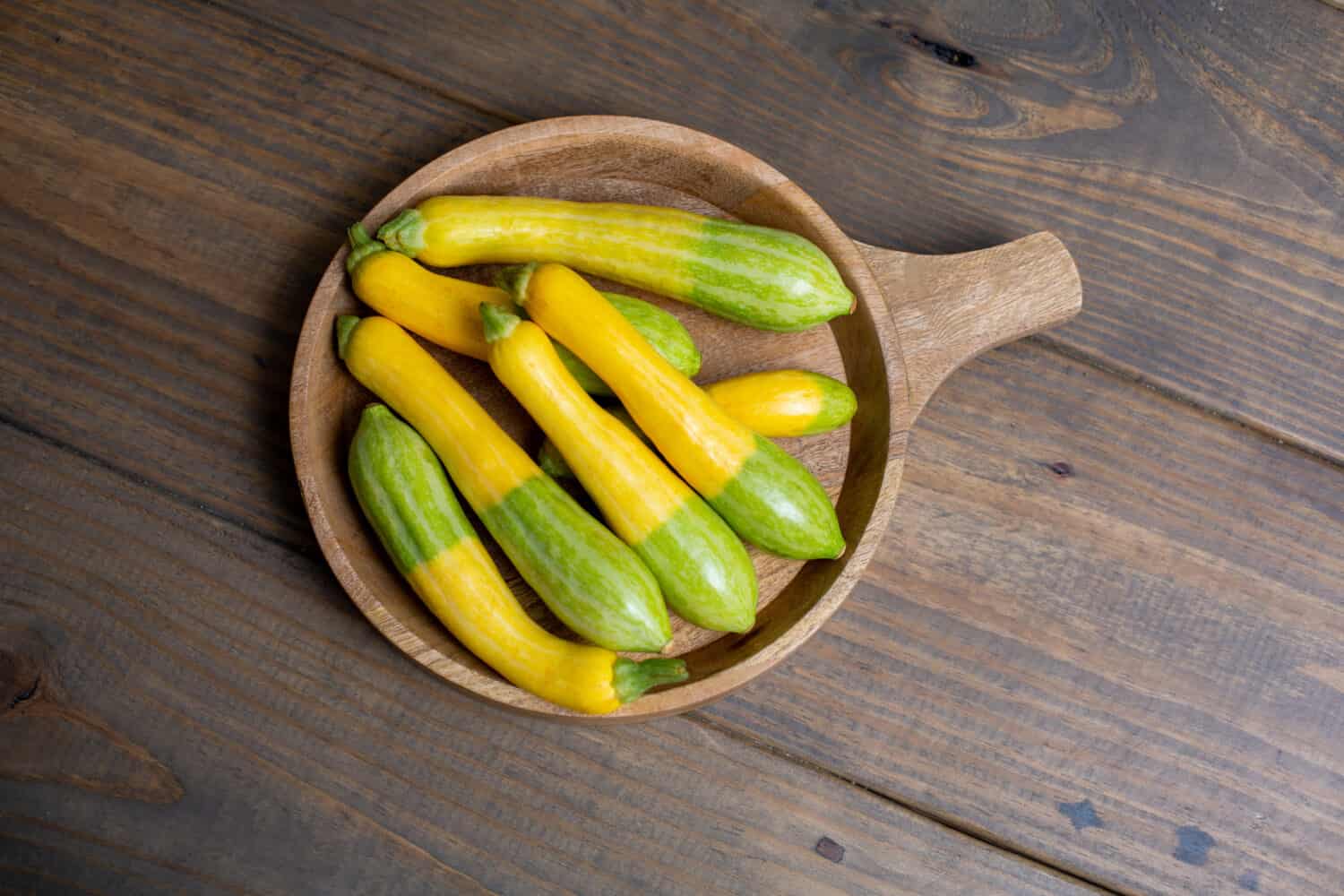
Although low in calories, zephyr squash is a nutrient-dense powerhouse!
©DiAnna Paulk/Shutterstock.com
13. Spaghetti Squash
If you’re looking for a low-calorie but nutrient-dense substitute for wheat-based spaghetti noodles, spaghetti squash is the answer. Spaghetti squash is oval-shaped and can range from small to large. The rind is usually golden yellow, and the flesh inside is a pale yellow which becomes stringy and fibrous when cooked, where it gets its name from. As a result, spaghetti squash is famous for its use as a pasta substitute due to its stringy texture.
Spaghetti squash contains vitamins C, and A, potassium, and dietary fiber. This unique type of squash has a mild and slightly sweet flavor.

Living up to its name, spaghetti squash is the perfect pasta replacement.
©vm2002/Shutterstock.com
14. Dumpling Squash
Dumpling squash, commonly known as sweet dumpling squash, is a small winter squash known for its round shape and sweet flavor. It has creamy ivory or pale-yellow skin with green stripes or mottling, giving it a cute and decorative appearance. Under the edible skin, this flavorful squash is creamy, tender, and smooth.
In addition to being a good source of vitamins, potassium, dietary fiber, and antioxidants, this nourishing little squash is relatively low in calories, making it a healthy addition to your diet. The dumpling squash is versatile and is a favorite in various recipes. You can peel the skin, boil the squash, and mash it. Add some butter and nutmeg for a delicious alternative to mashed potatoes. Roasting sweet dumpling squash is also a favorite among squash lovers!
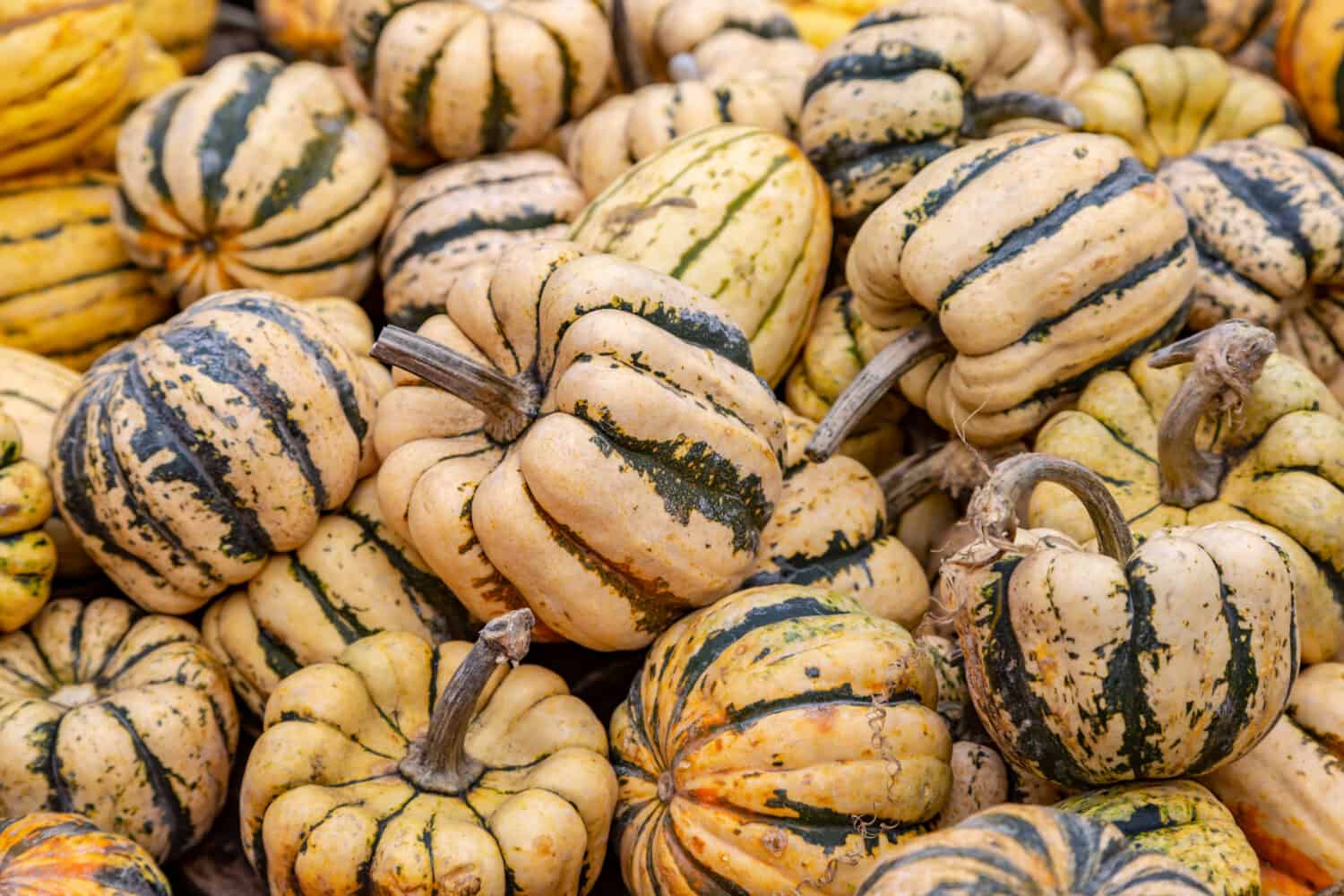
Squash lovers love dumpling squash for its flavor profile and versatility in recipes.
©Melanie Hobson/Shutterstock.com
Summary of the Different Types of Squash and Their Flavor Profile
| Squash Types | Flavor Profile | |
|---|---|---|
| 1 | Zucchini Squash | Mild, slightly sweet |
| 2 | Yellow Squash | Mild, slightly sweet |
| 3 | Butternut Squash | Mild, slightly sweet, and nutty |
| 4 | Pattypan Squash | Mild, slightly bitter |
| 5 | Delicata Squash | Rich, nutty, and sweet |
| 6 | Acorn Squash | Mild and buttery |
| 7 | Gold Rush Squash | Mild, slightly sweet, and nutty |
| 8 | Chayote Squash | Mild and sweet |
| 9 | Bonbon Squash | Sweet and creamy |
| 10 | Buttercup Squash | Mild, sweet, and nutty |
| 11 | Honey Bear Squash | Sweet and slightly nutty |
| 12 | Zephyr Squash | Slightly sweet and nutty |
| 13 | Spaghetti Squash | Mild and slightly sweet |
| 14 | Dumpling Squash | Sweet and creamy |
Thank you for reading! Have some feedback for us? Contact the AZ Animals editorial team.

